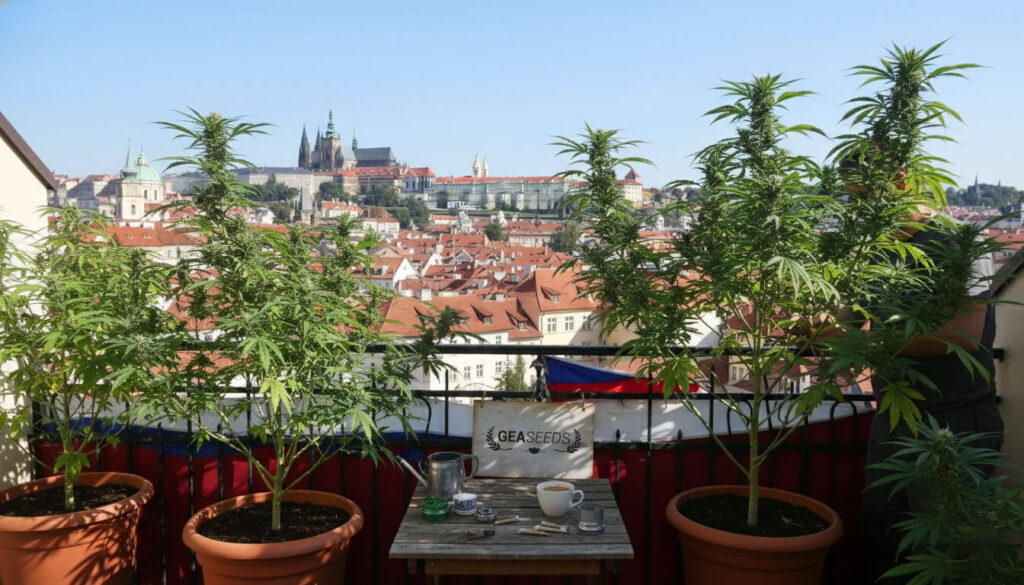The Czech Republic has once again placed itself on the European cannabis map. After years of relative tolerance and a medical cannabis program running since 2013, the country has approved a criminal law reform that, starting in January 2026, will allow the cultivation and possession of cannabis for personal use within clearly defined limits. The move fits within a global trend toward more flexible policies, reflected in the rise of cannabis consumers.

- 1 From tolerance to a much clearer law
- 2 Germany paved the way: direct influence on the Czech decision
- 3 What will be allowed in the Czech Republic from 2026 onward
- 4 From fine to crime: where the new law draws the line
- 5 And recreational sales? What the law doesn’t cover yet
- 6 What this means for users in the Czech Republic
- 7 A move that fits into the international cannabis landscape
- 8 Europe moves toward a new cannabis era
From tolerance to a much clearer law
The Czech Republic isn’t starting from scratch. Since 2010, the possession of small amounts of cannabis for personal use has been decriminalized, punishable by fines instead of prison sentences. Added to this, in 2013, was the creation of a medical cannabis program by prescription, allowing certain patients to access cannabis preparations through the healthcare system, albeit with several practical limitations.
Building on that foundation, in 2025 the Czech government promoted a broad revision of the Criminal Code with one central idea: to focus police and judicial efforts on organized crime rather than individuals who consume or cultivate for themselves. Within that package, cannabis regulations were updated, and clearer rules were introduced for other substances with therapeutic potential, such as psilocybin. It’s a similar path — in a European key — to that taken by countries with a long cannabis tradition such as Morocco, where the plant plays a major role in culture and the economy.
Germany paved the way: direct influence on the Czech decision
The Czech reform didn’t come out of nowhere. The decisive step taken by Germany in 2024 — legalizing personal cannabis use and allowing cultivation clubs — had a direct impact on its neighbors. Berlin showed that a large country with a solid healthcare and legal framework could regulate adult use without triggering institutional collapse.
This experience served as a reference for Czech lawmakers, who adapted the model to a smaller scale — focused on individual home cultivation and clearly defined possession limits. In fact, many analysts see Prague’s new law as a natural evolution of the German model, adjusted to a smaller nation with a pre-existing culture of tolerance.
Political exchange between both governments has been constant. While Germany works on the second phase of its plan to open regulated markets, the Czech Republic is advancing toward the legal consolidation of private use. Together, these cases draw a clear boundary in Central Europe and could speed up reforms in countries like Austria or Poland.
What will be allowed in the Czech Republic from 2026 onward
The core of the reform lies in personal use. Once the law takes effect on January 1, 2026, adults will have a defined legal framework to grow and store cannabis in moderate quantities:
- Minimum age: the regulation applies to people aged 21 and over.
- Home cultivation: up to 3 plants per person are allowed at home.
- Storage at home: up to 100 grams of dried flowers per household.
- Carrying in public: the limit is set at 25 grams.
Within those limits, possession and cultivation are considered legal as long as they are intended for personal use and there are no signs of sale. The goal is to ensure that people who organize their own supply at home don’t end up facing criminal charges for small quantities.
From fine to crime: where the new law draws the line
The Czech regulation sets a scale of consequences based on the amount cultivated or stored, distinguishing more precisely between personal use and production for profit:
- Up to 3 plants: permitted home cultivation.
- 4 or 5 plants: considered an administrative offense, punishable by a fine but without a criminal record.
- More than 5 plants: classified as a crime, potentially leading to prison sentences if interpreted as production for the illegal market.
The principle is clear — those who keep a few plants for self-supply are not treated the same as those running a hidden commercial operation. This distinction, still blurry in many countries, is now far better defined under Czech law.
And recreational sales? What the law doesn’t cover yet
An important clarification: the reform does not open a regulated recreational market. The changes concern individual use, possession, and home growing, but recreational sales remain illegal.

For now, commercial activity is limited to specific contexts such as medical cannabis dispensed in pharmacies under healthcare supervision and through licensed channels. Anything beyond that — recreational stores, dispensary chains, or clubs with direct sales — remains outside the legal framework, awaiting future legislation to determine whether and how that step will be taken.
What this means for users in the Czech Republic
For people who already consume cannabis in the Czech Republic, the most noticeable change will be the legal security. Being able to keep a few plants at home and store a limited amount of dried flowers without fear of criminal prosecution reduces dependence on the black market and allows for a more stable, self-managed form of consumption.
The main advantages are clear:
• Greater legal clarity for consumers and home growers.
• Reduction of the illicit market and the risk of arbitrary penalties.
• Lighter judicial workload for minor offenses related to use.
• More room for prevention and education policies promoting responsible use.
A move that fits into the international cannabis landscape
With this decision, the Czech Republic joins the group of countries that have moved beyond simple decriminalization to a legal framework where adult use is clearly regulated. The model is not identical to Germany’s, but both share a progressive approach that could accelerate a continental normalization of cannabis.
Globally, the Czech case adds to a long list of territories reexamining their relationship with the plant — from traditional producer countries like Morocco to nations without any historical cannabis ties but now driven by rising consumption and new scientific evidence.
Europe moves toward a new cannabis era
The new Czech cannabis regulation marks a turning point in how users are treated. From 2026 onward, growing a few plants at home and storing a small amount of dried flowers will be legal — as long as it remains within the established limits.
One key issue still remains unresolved: how a regulated market will be organized. It’s yet to be defined who will be allowed to produce on a large scale, what requirements retail points will face, or how taxation will be managed. Until those questions are settled, the Czech model will stand as an example of a country recognizing adult use and home cultivation while keeping the door closed to full-scale recreational sales.
Europe is moving toward a more realistic and human approach — where private cultivation, harm reduction, and user rights gain ground over traditional punitive logic. The combination of the German and Czech models shows that the continent is entering an era of political and social maturity regarding cannabis, with an eye toward a more coherent and sustainable form of regulation.



